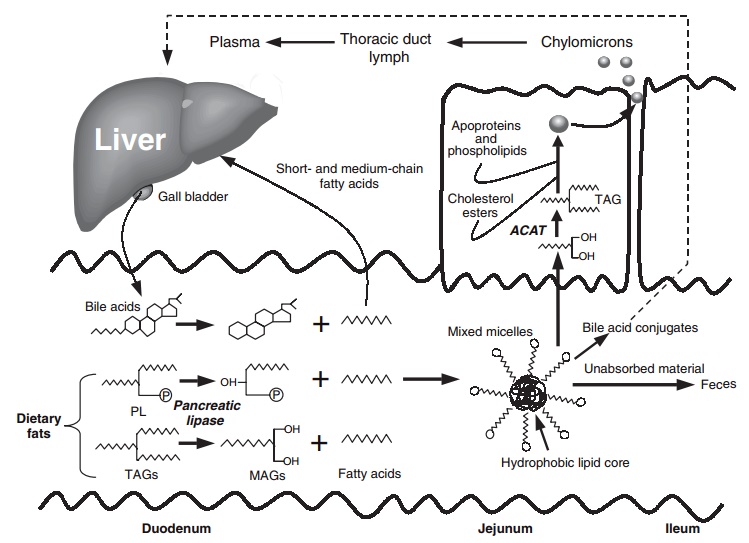Chapter: Introduction to Human Nutrition: Nutrition and Metabolism of Lipids
Reception, emulsification, lipolysis, solubilization, and absorption

Reception, emulsification,
lipolysis, solubilization, and absorption
secreted by the palate, although its contribution to lipolysis
in adults is questionable and thought to be more important in young suckling
infants, in which its release is stimulated by suckling and the presence of
milk. It is possible that this lingual lipase is carried into the stomach,
where it acts as a human gastric lipase (HGL) that has been shown to degrade up
to 10% of ingested fat. Although these early products of fat digestion, fatty
acids and monoacylglycerols, rep-resent a relatively minor component of fat
digested, their entry into the duodenum is believed to supply a major stimulus
for the production of the hormone cholecystokinin (CCK), which inhibits gut
motility.
The stomach serves mainly as an organ of mechan-ical digestion
and, by churning its contents, produces a coarse creamy emulsion known as
chyme. The cir-cular pyloric sphincter muscle that separates the stomach from
the duodenum and, with other factors, controls the rate of gastric emptying
opens twice a minute to release approximately 3 ml of chyme. Since emulsified
fat in chyme is less dense than the aqueous material, the two fractions
separate with the fat col-lecting above the aqueous layer. As a result, the
entry of emulsified fat into the duodenum is delayed, allow-ing sufficient time
for the minor breakdown products to act on CCK.
The duodenal phase involves the breakdown of the emulsified fat
by a process known as lipolysis and the solubilization of the products of
lipolysis. The entry of chyme containing minor lipolytic products into the
duodenum stimulates the:
●release of CCK, which inhibits gut motility
●secretion of bile acids from the gall bladder
●release of pancreatic juice containing a battery of lipases.

Figure 6.4 Reception, emulsification, lipolysis, solubilization, and absorption of fats. ACAT, acyl-CoA-cholesterol acyltransferase; MAG, mono-acylglycerol; TAG, triacylglycerol; PL phospholipid; P, phosphate.
Lipolysis is an enzyme-catalyzed hydrolysis that releases fatty
acids from lipids (TAGs, phospholipids, and CEs). It involves the hydrolytic
cleavage of bonds between a fatty acid and the glycerol backbone of TAGs and
phospholipids, and cholesterol in CEs, and occurs not only in the digestive
tract but also in cir-culating and intracellular lipids (Figure 6.4). The
hydrolysis of emulsified dietary fat entering the duo-denum is catalyzed by a battery
of pancreatic enzymes including a pancreatic lipase that acts chiefly on TAG
and phospholipase A2 and a cholesterol ester hydro-lase acting on
phospholipids and CEs. The hydrolysis of TAG by pancreatic lipase occurs in a
sequential fashion with the initial removal of a fatty acid from position 1 and
then position 3 from the glycerol back-bone, generating a 2,3-diacylglycerol,
followed by a 2-monoacylglycerol (2-MAG).
Related Topics